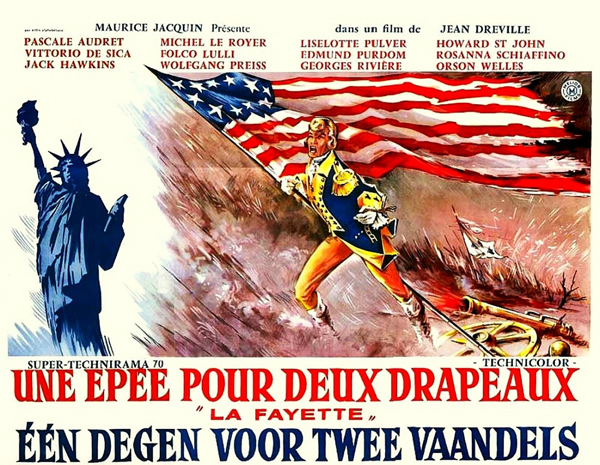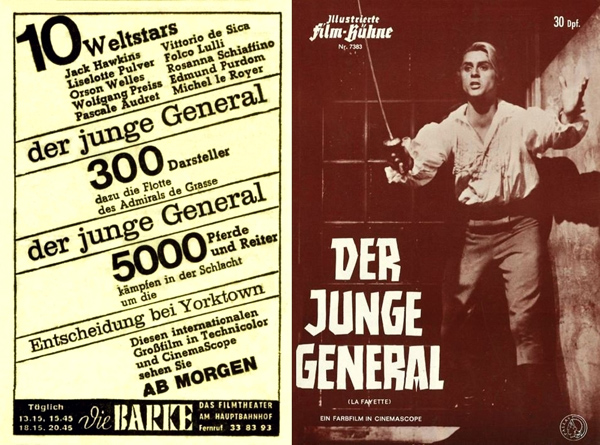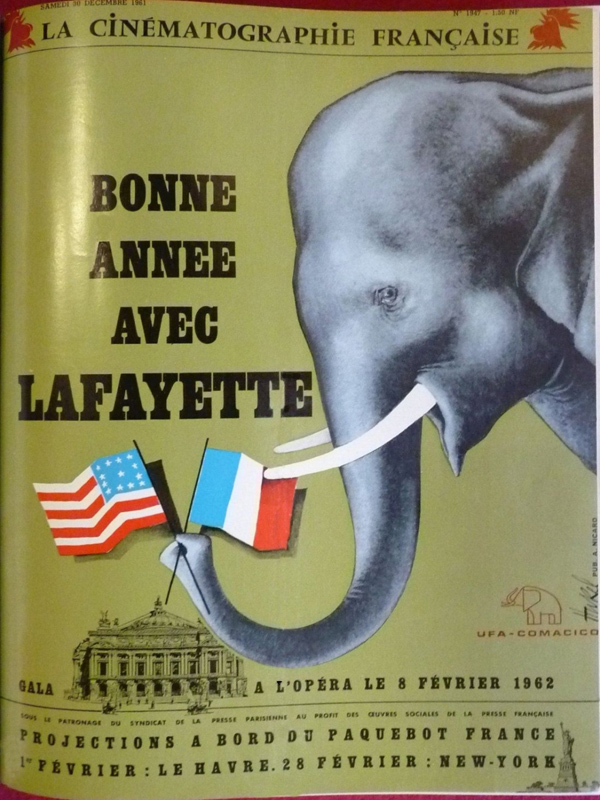"La Fayette", Preview, World Premiere and more |
Read more at in70mm.com The 70mm Newsletter |
| Written, compiled and translated by: Gerhard Witte, Berlin, Germany, in March/April 2020 | Date: 01.05.2020 |
 LA
FAYETTE – A sword for two flags (Une épée pour deux drapeaux – Één degen voor
twee vaandels) LA
FAYETTE – A sword for two flags (Une épée pour deux drapeaux – Één degen voor
twee vaandels)Jean Dréville's La Fayette (France/Italy, 1962) is a large cinematic historical fresco, an expensive Franco-Italian production that describes France's participation in the American War of Independence. In 1776, thirteen British colonies in America have begun to rise up against the British crown, intent on creating their own independent republic (declaration of Independence of the United States by the Continental Congress on 4th July 1776). News of the revolution reaches the Royal Court of France, and excites the imagination of one particular aristocrat and soldier, the 19-year-old Marquis Gilbert de La Fayette. The wealthy French officer and nobleman (in the film performed by Michel Le Royer), a hot supporter of the ideas of Voltaire and Jean-Jacques Rousseau, comes to America´s aid with men, money and weapons in order to join and help American insurgents in the fight against the British. At the time of his first arrival in America (in June 1777), La Fayette was without combat experience. • Go to PDF report about "La Fayette" Later, as one of George Washington's most trusted aides and close personal friend, he became Major General in the Continental Army. On the battlefield, La Fayette proves himself a worthy ally. The last decisive battle took place at Yorktown (Virginia) in 1781 – that was the beginning of American independence … "they are free", and here the film is ending. So, it only describes a part of La Fayette's life. In 1782 he returned to France and started his second career – as a politician, where he had played a prominent part in the French Revolution. In 1824, almost at the age of 67 (ten years before his death on 20.05.1834), the United States gave La Fayette the highest honor it could bestow on a private citizen of another country. By act of Congress he was invited to visit the United States as an official "Guest of the Nation". The last surviving General of the French Revolution, La Fayette, arrived by ship in the United States at Staten Island (New York) on 15th August 1824. His arrival had been greeted with a thirteen-gun salute from the batteries of "Fort Lafayette" [so named since 1823 (former name "Fort Diamond") – an island coastal fortification in the narrows of New York harbor that had been demolished in 1960]. At the time, La Fayette was kindly requested to delay his entrance into Manhattan as the city was observing the Sabbath and would not be able to welcome him appropriately, and also some preparations had to be done. But on the following day Lafayette and his entourage landed at "Castle Clinton", situated next to the Battery Park (The Battery), where an enormous military escort had been assembled to usher him along the Broadway to the New York City Hall in order to be greeted by Mayor Stephen Allen there. Along the route, he had been celebrated by over 50,000 enthusiastic people. La Fayette's secretary, Auguste Levasseur, wrote at the time that it had been "impossible to describe". The film has a good cast, superb sets, luxurious costumes, a pleasant musical score, and magnificent images by Roger Hubert's and Claude Renoir's cinematography – shot in Technirama (negative format 35mm horizontal). In my mind's eye, it is beautiful to watch and informative – the soldiers' uniforms fit perfectly and are looking incredibly clean, even often during the fights. It proves that French cinema could embark on ambitious and expensive subjects at that time. The English and Americans in the film partly speak in their native English (with French subtitles), which I find not bad and contributes to the authenticity of the scenery. |
More in 70mm reading: "La Fayette" in CINERAMA • PDF: "La Fayette" "La Fayette" in CINERAMA Super Technirama 70 Gerhard Witte's in70mm.com Library Internet link: |
 "La
Fayette" presented in Super Technirama 70 – from the movie's opening
credits. "La
Fayette" presented in Super Technirama 70 – from the movie's opening
credits.At the time, "La Fayette" had been advertised as "Le plus grand film français jamais réalisé à la gloire du héros de la Liberté" – "The greatest French film ever made to the glory of the hero of Liberty". Maurice Jacquin, the film's producer, reports in an article in the trade magazine "Le Film Français Cinémonde" (Édition Spéciale) dated 01.02.1962:
I have been informed that alone in France
an audience of about 3.7 million had watched it at the time of its premiere.
So, it is somehow a little bit strange that Jean Dréville's spectacular is
nearly virtually forgotten in today's French collective memory.
The film "La Fayette" (French
spelling, the other is "Lafayette") had experienced a preview in Le Havre
(France) on the newly built passenger vessel (paquebot) "S.S. France" while
still dockside on 01.02.1962. The ship began its maiden voyage from Le Havre
via Southampton to New York two days later, on 03.02.1962. It lasted 6 days.
The ship had been equipped with a huge theatre auditorium, which was
equipped with [DP70]
70/35mm projectors
(more information on this in the report).
For the La Fayette preview event, invited film industry guests and others
were transported by train from Paris to Le Havre. |
|
The Movie's Hamburg (Germany) Premiere in CinemaScope on 23.09.1966 |
|
 On
the left an advert taken from the newspaper "Hamburger Abendblatt" dated
22.09.1966 that announces the movie´s premiere on the following day: 10
world stars – Der junge General (The young General) – 300 performers and the
fleet of the Admiral de Grasse – 5000 horses and riders fight in the battle
for the decision at Yorktown – You will see this Major International Film in
Technicolor and CinemaScope from tomorrow at Hamburg´s "Die Barke" cinema. On
the left an advert taken from the newspaper "Hamburger Abendblatt" dated
22.09.1966 that announces the movie´s premiere on the following day: 10
world stars – Der junge General (The young General) – 300 performers and the
fleet of the Admiral de Grasse – 5000 horses and riders fight in the battle
for the decision at Yorktown – You will see this Major International Film in
Technicolor and CinemaScope from tomorrow at Hamburg´s "Die Barke" cinema.
On the right the movie´s German program "Illustrierte Film-Bühne" (No. 7383), distributor: Pallas Film. The film only ran briefly at "Die Barke" – until 29.09.1966. German title: Der junge General. • Go to PDF report about "La Fayette" |
|
More Trivia |
|
 UFA-COMACICO
(elephant) advertising: "HAPPY NEW YEAR WITH LA FAYETTE"- the front page of
the trade magazine "La Cinématographie Française" dated 30.12.1961. UFA-COMACICO
(elephant) advertising: "HAPPY NEW YEAR WITH LA FAYETTE"- the front page of
the trade magazine "La Cinématographie Française" dated 30.12.1961.Gala at the Paris Opera on 08.02.1962 - under the patronage of the Parisian press union for the benefit of social works of the French press. Screenings on board of the passenger vessel "France": on 01.02.1962 (Le Havre ) / on 28.02.1962 (New York). |
|
 "La
Fayette" information left from the newspaper "New York Daily News" dated
11.04.1963, and right from the British trade magazine "Films and Filming"
dated March 1965. "La
Fayette" information left from the newspaper "New York Daily News" dated
11.04.1963, and right from the British trade magazine "Films and Filming"
dated March 1965.La Fayette had its official US premiere at New York´s "DeMille Theatre" on 10.04.1963 - a MACO Film Corporation release. At the time, they had created an own version of the film. The original French premiere version has a runtime of 158 minutes, the new US version now only 110 - or most likely 112 minutes. La Fayette premiered in the UK at London´s "Coliseum Cinerama Theatre" on 10.01.1965 - distributed by CINERAMA. Here with a runtime of 112 minutes too. The new French Blu-ray version of the film has a runtime of 142 minutes. |
|
| Go: back - top - back issues - news index Updated 28-07-24 |
